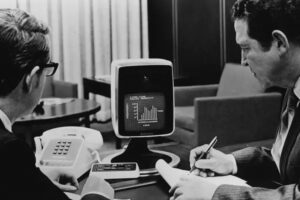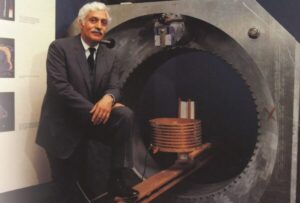A barometer is an instrument used to measure atmospheric pressure, which is a key component in weather forecasting and understanding atmospheric changes. This device plays a crucial role in providing valuable information about the state of the atmosphere. One such instrument that was widely used in the past is the mercury barometer.
The mercury barometer, with its simple yet effective design, was the go-to tool for measuring atmospheric pressure for centuries. It consisted of a glass tube filled with mercury, inverted into a reservoir of the same liquid. As the atmospheric pressure changed, the mercury in the tube would rise or fall, indicating the corresponding pressure level.
Table of Contents
Historical Background
The history of barometers and their development can be traced back to the 17th century when scientists began exploring ways to measure atmospheric pressure. The barometer was a revolutionary invention that allowed for the quantification of atmospheric pressure, which was vital for weather forecasting and understanding the behavior of gases.
One of the most notable barometers of that time was the mercury barometer, an innovative measuring instrument that gained immense popularity in the scientific community during the 17th to 19th centuries. This instrument, which utilized mercury as the operating medium, was a significant advancement in measurement technology.
The mercury barometer was lauded for its accuracy and reliability in measuring atmospheric pressure. It consisted of a glass tube filled with mercury, which was then inverted and placed in a reservoir of mercury. As atmospheric pressure changed, the mercury in the tube would rise or fall, indicating variations in pressure. This simple yet ingenious principle allowed scientists to obtain precise measurements of atmospheric pressure, leading to groundbreaking discoveries in meteorology and the physical sciences.
During its heyday, the mercury barometer was widely used by renowned scientists such as Torricelli, Pascal, and Boyle. Its popularity was driven by its ability to provide accurate and consistent measurements, enabling researchers to delve deeper into the workings of the natural world. This instrument played a critical role in advancing our understanding of the atmosphere and paved the way for modern meteorology.
However, with the passage of time, the mercury barometer gradually fell out of favor. Despite its merits, there were several limitations and safety concerns associated with its use. The fragile glass tubes used in its construction were prone to breakage, making the instrument delicate and difficult to transport. Additionally, the toxicity of mercury posed significant health hazards, both for the users and the environment. The need for safer, more portable, and user-friendly measuring instruments eventually led to the decline of the mercury barometer.
Today, while the mercury barometer may be considered a forgotten instrument, its historical importance remains undeniable. It played a pivotal role in the development of meteorology and our understanding of atmospheric processes. As we embrace modern technological advancements in measurement instruments, it is important to acknowledge and appreciate the contributions made by this innovative and influential device. By preserving and learning from the past, we can ensure that heritage scientific instruments are not forgotten but rather celebrated as milestones in the evolution of scientific progress.
Principle of Operation
The principle of operation behind the mercury barometer is based on the relationship between atmospheric pressure and the height of a column of mercury. As one of the earliest and most accurate measuring instruments, the mercury barometer played a vital role in understanding and predicting weather patterns.
The fundamental principle behind mercury barometers lies in the fact that atmospheric pressure can support a column of liquid in a vacuum-sealed tube. In the case of a mercury barometer, a glass tube is filled with mercury and turned upside down into a reservoir of mercury. The barometer is then exposed to the external atmospheric pressure, and the mercury inside the tube settles at a certain height above the mercury reservoir.
The density of mercury plays a crucial role in the functioning of the barometer. Mercury is a dense liquid, around 13 times denser than water, allowing for smaller and more accurate measurements. The increasing density of mercury with higher pressure further influences the height of the mercury column in the tube.
To better understand the principle, it is important to make a brief comparison to other types of barometers. Unlike the mercury barometer, aneroid barometers use a flexible metal chamber instead of liquid. These barometers are designed to detect pressure changes and are widely used today due to their compact size and portability. On the other hand, electronic barometers utilize sensors and transducers to measure pressure variations, offering precise and real-time readings.
In conclusion, the mercury barometer operates based on the fundamental principle that the atmospheric pressure can support a column of mercury. Its accurate measurements were made possible by the density of mercury and its relationship with pressure. While other barometer types have emerged, the mercury barometer remains a significant measuring instrument in the history of scientific discovery.
Construction and Components
A mercury barometer is composed of several essential components that work together to accurately measure atmospheric pressure. Let’s take a closer look at each of these components.
Glass tube: The barometer consists of a long, narrow glass tube, typically filled with mercury. The glass tube is sealed at one end and open at the other end, allowing for the movement of mercury.
Mercury reservoir: At the sealed end of the glass tube, there is a bulb-shaped reservoir filled with mercury. This reservoir acts as a source of mercury for the rest of the barometer.
Torricellian vacuum: The glass tube is inverted into a dish filled with mercury. As the tube is inserted, the mercury reservoir is placed below the surface of the mercury in the dish. This creates a vacuum, known as the Torricellian vacuum, in the space above the mercury in the tube.
The combination of these components is crucial in the operation of a mercury barometer, as they allow for the measurement of atmospheric pressure.
Explanation of how these components work together: To measure atmospheric pressure, the open end of the glass tube is exposed to the surrounding air. As the air pressure changes, it exerts force on the surface of the mercury in the dish. This pressure is then transmitted through the mercury in the tube and balanced against the weight of the mercury in the reservoir.
The height of the mercury column in the tube fluctuates in response to changes in atmospheric pressure. By measuring the height of the mercury column, the atmospheric pressure can be determined.
It is important to note that the height of the mercury column is inversely proportional to the atmospheric pressure. As the pressure increases, the mercury column decreases in height, and vice versa.
In summary, the glass tube, mercury reservoir, and Torricellian vacuum work together to create a sensitive and accurate instrument for measuring atmospheric pressure. The mercury barometer’s construction allows for the precise measurement of these pressure changes, contributing to the understanding of weather patterns and atmospheric phenomena.
Usage and Importance
The mercury barometer, once a widely used measuring instrument, played a significant role in various applications, showcasing its importance in understanding atmospheric changes and weather forecasting. By measuring atmospheric pressure, the mercury barometer provided valuable insights into the behavior of the atmosphere, helping scientists gain a better understanding of weather patterns and atmospheric conditions.
One of the most important roles of the mercury barometer was in weather forecasting. By monitoring changes in atmospheric pressure, meteorologists were able to predict weather patterns and make informed forecasts. Changes in pressure indicated the movement of air masses, which were crucial in determining the development of weather systems such as storms, hurricanes, and fronts. Therefore, the use of mercury barometers was instrumental in predicting and understanding weather phenomena.
Throughout history, many famous scientists utilized mercury barometers in their research. One notable example is Torricelli, the Italian physicist who invented the mercury barometer in 1643. His groundbreaking work led to the discovery of the principles behind barometric measurements and the establishment of atmospheric pressure as a fundamental concept in physics. Other notable scientists, such as Pascal and Galileo, also extensively used mercury barometers in their studies, contributing to the advancement of atmospheric science.
The significance of the mercury barometer extended beyond weather forecasting and scientific research. It was also widely used in areas such as aviation, agriculture, and engineering. In aviation, pilots relied on barometric pressure measurements to determine altitude and ensure safe flying conditions. In agriculture, barometric pressure played a role in predicting crop yields and facilitating optimal planting and harvesting times. Additionally, engineers utilized mercury barometers to monitor pressure changes in applications such as vacuum systems, air conditioning, and industrial processes.
Despite its vital role in scientific research and practical applications, the usage of the mercury barometer has declined over the years due to various drawbacks and safety concerns. The fragile nature of glass tubes and the potential breakage of mercury barometers posed risks of contamination and injury. Moreover, the environmental hazards associated with mercury toxicity have led to the adoption of alternative measuring instruments that are safer and more environmentally friendly.
In conclusion, the mercury barometer played a crucial role in the past, showcasing its significance in weather forecasting, understanding atmospheric changes, and scientific research. Its contributions to various fields, along with the pioneering work of famous scientists who utilized mercury barometers, are undeniable. However, the drawbacks and safety concerns associated with the mercury barometer led to its decline in usage and the emergence of contemporary alternatives that offer improved accuracy, portability, and safety. It is essential to recognize and appreciate the mercury barometer as a heritage scientific instrument while embracing advancements in measuring technology.
Drawbacks and Safety Concerns
The mercury barometer, although once a popular measuring instrument, has several drawbacks and safety concerns that have led to its decline in usage and the need for alternative measuring instruments.
One of the main drawbacks of mercury barometers is their fragility and the potential for glass tubes to break. The glass tube, which is an essential component of the barometer, is susceptible to damage due to its delicate nature. Even a slight mishandling or accidental impact can result in the breakage of the tube, rendering the barometer useless. This fragility makes the mercury barometer a less practical option, especially in environments where durability is crucial, such as outdoor research stations or remote weather stations.
Another significant safety concern associated with mercury barometers is the environmental hazards related to mercury toxicity. Mercury, a toxic heavy metal, is used as the measuring fluid in these barometers. In the event of a broken glass tube, mercury can be released into the environment, posing a threat to human health and the ecosystem. Exposure to mercury can lead to severe health problems, including neurological disorders and organ damage. Consequently, the use of mercury barometers has become increasingly regulated, with guidelines in place to ensure proper handling and disposal of these instruments.
Due to these drawbacks and safety concerns, the popularity of mercury barometers has waned over time, giving rise to the need for alternative measuring instruments. Scientists and researchers have sought safer and more durable options that offer comparable or even improved accuracy. Electronic and aneroid barometers have emerged as popular alternatives to mercury barometers in recent times.
Electronic barometers utilize electronic sensors to measure atmospheric pressure. By incorporating advanced technology, these instruments offer greater accuracy and reliability. They are also more portable and user-friendly, with digital displays and the ability to record and analyze data. Additionally, electronic barometers eliminate the need for mercury, making them safer for both users and the environment.
Aneroid barometers, on the other hand, operate without the use of any liquids. Instead, they employ a flexible metal diaphragm that expands or contracts with changes in atmospheric pressure. This movement is transmitted to a mechanical mechanism, which then displays the pressure reading. Aneroid barometers are compact, durable, and do not pose the risk of mercury spillage. They are widely used in various applications, including aviation, meteorology, and outdoor activities.
In conclusion, while the mercury barometer was once a widely used measuring instrument, drawbacks and safety concerns have led to its decline in usage. Fragility and the potential breakage of glass tubes, coupled with environmental hazards associated with mercury toxicity, have prompted the development and adoption of alternative measuring instruments. Electronic and aneroid barometers now offer greater accuracy, portability, and safety. However, it is essential to acknowledge the historical significance of the mercury barometer and ensure the preservation and appreciation of these heritage scientific instruments.
Contemporary Alternatives
With the advancements in technology, modern barometer technology has taken over the use of mercury barometers. Two popular alternatives to the traditional mercury barometer are electronic and aneroid barometers.
Electronic barometers have gained popularity due to their accuracy and ease of use. These barometers rely on electronic sensors to measure atmospheric pressure. The sensors capture the pressure changes and display the readings on a digital screen. This technology allows for precise and highly accurate measurements, making it ideal for professional meteorologists and weather enthusiasts alike.
On the other hand, aneroid barometers are mechanical devices that do not require any liquids, including mercury, to measure atmospheric pressure. Instead, they utilize a metal chamber that expands and contracts with changes in pressure. These changes are then translated into corresponding pressure readings on a dial, which can be easily read and interpreted. Aneroid barometers are known for their portability and durability, making them popular choices for outdoor activities like hiking and sailing.
In comparison to mercury barometers, both electronic and aneroid barometers offer several advantages. Accuracy is a key advantage, as electronic barometers can provide real-time, precise readings, while aneroid barometers are known for their reliability in delivering consistent measurements. Moreover, these alternatives are portable and can be easily carried from one location to another, allowing users to monitor atmospheric pressure anytime and anywhere.
Another significant advantage of electronic and aneroid barometers is safety. The use of mercury in traditional barometers poses a serious risk of mercury poisoning if mishandled or if the barometer breaks. Electronic and aneroid barometers eliminate this risk entirely, making them more environmentally friendly and user-friendly.
While these contemporary alternatives have replaced the mercury barometer in most applications, it’s important to acknowledge the historical significance and pioneering role played by the mercury barometer in atmospheric pressure measurement. By embracing modern technologies, we can ensure more accurate and safe measurements, while still appreciating and conserving the cultural heritage associated with traditional scientific instruments.
Conclusion
In conclusion, the mercury barometer holds a significant place in history as a forgotten measuring instrument. Its invention revolutionized the field of atmospheric pressure measurement and played a crucial role in weather forecasting during the 17th to 19th centuries. The mercury barometer was a testament to scientific innovation and understanding during that time period, and its popularity in the scientific community cannot be overstated.
Unfortunately, in modern times, the mercury barometer has been overshadowed by more contemporary alternatives. While its principle of operation and accuracy were commendable, the drawbacks and safety concerns associated with using mercury as a filling material led to its decline in usage. Fragility and potential breakage of the glass tubes as well as the environmental hazards related to mercury toxicity were major concerns that necessitated the development of alternative measuring instruments.
Today, electronic and aneroid barometers have replaced mercury barometers due to their advantages in terms of accuracy, portability, and safety. These modern instruments have taken advantage of advancements in technology and offer more convenience and ease of use in atmospheric pressure measurement. Nevertheless, it is vital to acknowledge and appreciate the historical significance of the mercury barometer and other heritage scientific instruments.
The conservation and appreciation of heritage scientific instruments like the mercury barometer are important for various reasons. They serve as reminders of the ingenuity and accomplishments of scientists from the past. By preserving and studying these instruments, we can gain a deeper understanding of the scientific progress that led us to where we are today. Additionally, such conservation efforts allow future generations to appreciate the rich history of scientific exploration and inspire them in their own scientific pursuits.
In conclusion, the mercury barometer may be a forgotten measuring instrument in modern times, but it should not be forgotten completely. Its historical importance, contributions to scientific research, and legacy as a scientific symbol make it worthy of recognition and preservation. By valuing and protecting these heritage instruments, we can ensure that the achievements and knowledge of our scientific predecessors continue to inspire and guide us in the future.




